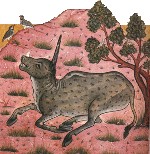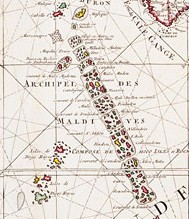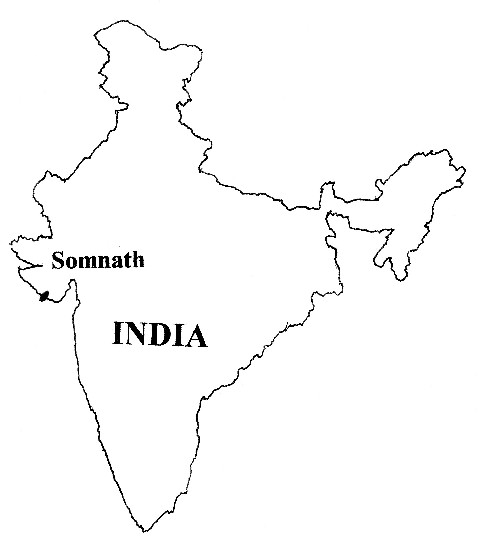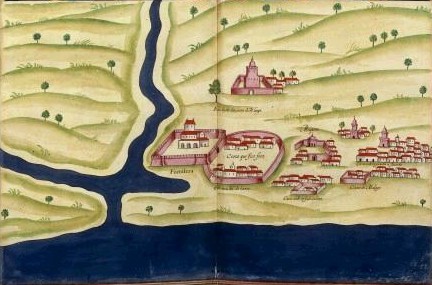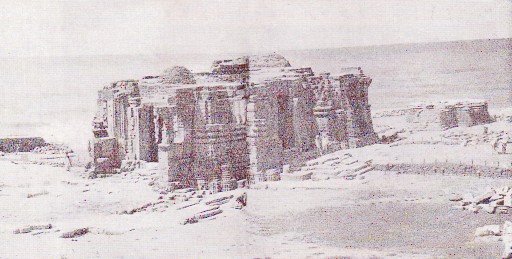
To next page
Al-Biruni (1050) from Khwarazm at the Aral sea coast (Teareikh al-India) (book on India)
----------------------------------
The (modern version of the) legendary shore temple of Somnath. Which was visited by lots of traders of East Africa.
Al-Biruni's book on India is written to make Hinduism understandable to the Muslim scholar as well as its culture and its science. During the whole book he explains, Hinduism, the laws, culture and science of India by comparing it with Arab ideas and the ideas of the classical Greek. Several times he speaks about east Africa, once when describing the world, a second time when describing the Indian Ocean and also when talking about idols in the city of Somanah. Last when talking about the Maldives.
Al-Biruni wrote the book when traveling in northern India, where he worked for the Moslem Emperor who had concurred the country. Every paragraph comes from a different part of the book.
For in certain places the continent protrudes far into the ocean, so as to pass beyond the equator. E.g. the plains of the Negroes in the west, which protrudes far towards the south, even beyond the mountains of the moon and the sources of the Nile, in fact, into regions which we do not exactly know. For that continent is desert and impassable, and likewise the sea behind Sufale of the Zanj is un-navigable. No ship which ventured to go there has ever returned to relate what it had witnessed.
The ganda exist in large numbers in India, more precisely around the Ganges. It is of the built of a buffalo, has a black scaly skin, and dewlaps hanging down under the chin. It has three yellow hoofs on each foot, the biggest one forward, the others on both sides. The tail is not long, the eyes lie low, further down the cheek than is the case with all other animals. On the top of the nose there is a single horn which is bend upwards. The Brahmins have the privilege of eating the flesh of the ganda. I myself have witnessed how an elephant coming across a young ganda was attacked by it........
I thought the ganda was the rhinoceros (or Karkadann) but a man who had visited Sufala in the country of the Negroes told me that the Kark, which the Negroes call impila, the horn of which furnishes the material for the handles of our knives, comes nearer this description then the rhinoceros. It has various colors. On the skull it has a conical horn, broad at the root, but not very high. The shaft of the horn (literally its arrow) is black inside, and white everywhere else. On the front it has a second and larger horn of de same description, which becomes erect as soon as the animal wants to ram with it. It sharpens this horn against the rocks, so that it cuts and pierces. it has hoofs, and a hairy tail of an ass.
The islands in the eastern part of the Indian ocean which are close to China are the Zabedj. The islands in the western part are the islands of the Zendj (Negroes) and those in the middle are the islands of Ramu and the Diva Islands. (Maldives and Lacadive) to which belongs also the Komair islands......the islands are divided into two classes, according to the nature of their staple product. Those of one class are called Diva- Kuzah (or the cowry Divas) (Diva isles means isles of the middle) because of the cowries which are gathered from coco- tree branches planted in the sea. The others are called Diva- kanbar from the word kanbar signifying the cord plaited from the fiber of the coco-tree with which they stitch their ships together...... The Islands of Al wakwak belongs to the Kumair islands.... (They are white).... Some of the inhabitants of Wakwak island are black in color. In our countries there is a great demand for them as slaves. People fetched from there the black ebony wood, it is the pitch of a tree the other parts are thrown away, while the kinds of wood called mulamma and shauhaf and the yellow sandal-wood are brought from the country of the Zandj.
In former times there were pearl banks in the bay of Sarandib (Ceylon) but at present they have been abandoned, since the Sarandib pearls have disappeared, other pearls have been found at Sufala in the country of the Zanj, so that people say the pearls of Sarandib have migrated to Sufala.
Note, this last paragraph can be seen as an argument in the discussion about to whom belong the ruined Swahili cities who according to oral tradition belonged to the Wadiba.
It is very unlikely that this were pure Maldives settlements, because the ruins are real Swahili ruins, but places with special commercial relations with the Maldives, and counting among them a certain percentage of Maldives people or their descendents.
It also relates to a passage of Ibn Battuta who talks about the export of cowries shells from the Maldives. And a passage from Abu Zaid Hassan of Siraf who talks about the coastal people of Oman behaving in the same way as described above for the people of the Maldives.
In the south west of the Sindh country .......... Somanath was the most famous of these places.
The reason why in particular Somanath has become so famous is that it was a harbor for seafaring people, and a station for those who went to and fro between Sufala in the Country of the Zanj and China.
We know only of the color of burnt silver, which occurs e.g. among the Zanj, who lead a live without sorrow and envy as they do not possess anything which gives birth to these passions. They live no doubt longer then we, but only a little longer, and by no means twice as long. The Zanj are so uncivilized that they have no notion of a natural death. If a man dies a natural death, they think he was poisoned. Every death is suspicious with them, if a man has not been killed with a weapon. Likewise it is regarded with suspicion by them, if a man is touched by the breath of a consumptive person.
The continent protrudes far into the sea in the western half of the earth, and extends its shores far into the south. On the plains of this continent live the western Negroes, whence the slaves are brought, and there are the mountains of the moon and on them are the sources of the Nile. On its coast, and the islands before the coast, live the various tribes of the Zanj. There are several bays or gulfs which penetrate into the continent on this western half of the earth- the bay of Berbera, that of Klysma (red sea) and that of Persia, and between these gulfs the western continent protrudes more or less into the ocean.
Note on Biruni's Somnath :
The legendary shore temple of Somnath is about 5km from Veraval (A large coastal industrial center) also situated 79 km from Junagadh and 25 km from Chorwad, Somnath is one of the twelve most sacred Shiva shrines in India and had a checkered history. It is believed that the Somnath temple here was originally built by Somraj, the Moon God himself, out of gold, then rebuilt by Ravana in silver and then by Krishna in Wood, and yet again by King Bhimdev Solanki in stone in the 10th century. Ghazni Mohammed descended on Somnath in 1024 when the temple was so prosperous that it has 300 musicians, 500 dancing girls and 300 barbers to shave the heads of visiting pilgrims. There is a description to this effect by Al Biruni, an Arab traveler. After a two-day battle, Ghazni Mohammed carted off its fabulous wealth In 1706 Aurangzeb, the Mughal emperor converted it into a mosque. It was rebuilt in 1950 A.D. with the support of Sardar Vallabhbhai Patel (minister of interior).
